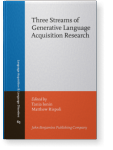Acquisition of word order in L2 Spanish
The case of the auxiliary haber in conjunction with manner adverbs
Previous studies on Spanish adverb placement investigated how English natives reset their L1 [‑raise] to [+raise] but neglected the acquisition of adverb placement with haber (particularly, manner adverbs). The acquisition of haber/Participle/Adverb in Spanish depends on (1) the apparent lack of autonomy of haber forms, and (2) the neutral syntactic position of the adverb. To investigate the acquisition of “haber + manner adverb” by Spanish learners, 18 Spanish monolinguals and 33 L1 English Spanish learners completed a Grammaticality Judgment Task and an Explicit Production Task. Results suggest that (a) haber verbal forms lack autonomy; (b) había behaves as a syntactic clitic, and ha as a syntactic-phonological clitic; and (c) acquisition of “haber + manner adverb” order occurs successfully in learners.
Article outline
- 1.Introduction
- 2.Previous literature on the acquisition of word order in L2 Spanish: The case of manner adverbs and lexical verbs
- 3.Auxiliary haber + manner adverbs word order
- 4.Research questions and hypotheses
- 5.Methodology
- 5.1Participants
- 5.2Experimental tasks
- 5.2.1Task 1: Grammaticality Judgment Task (GJT)
- 5.2.2Task 2: Explicit Production Task (EPT)
- 5.3Procedure
- 5.4Scoring
- 6.Results
- 6.1Task 1
- 6.1.1Spanish monolingual group
- 6.1.2Bilingual groups
- 6.2Task 2
- 6.2.1Spanish monolingual group
- 6.2.2Bilingual groups
- 7.Discussion
- 8.Conclusions
-
Notes
-
9. References
